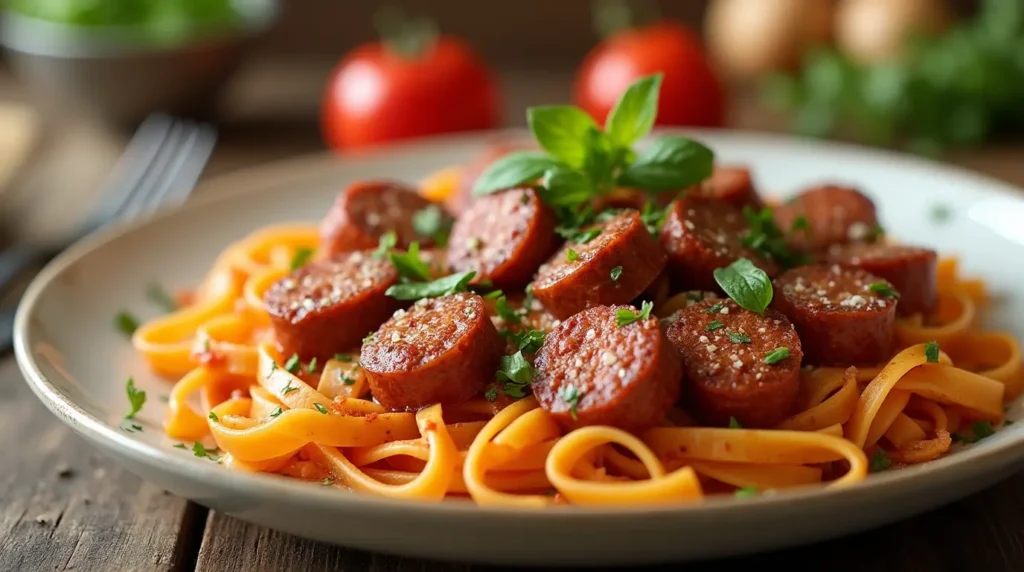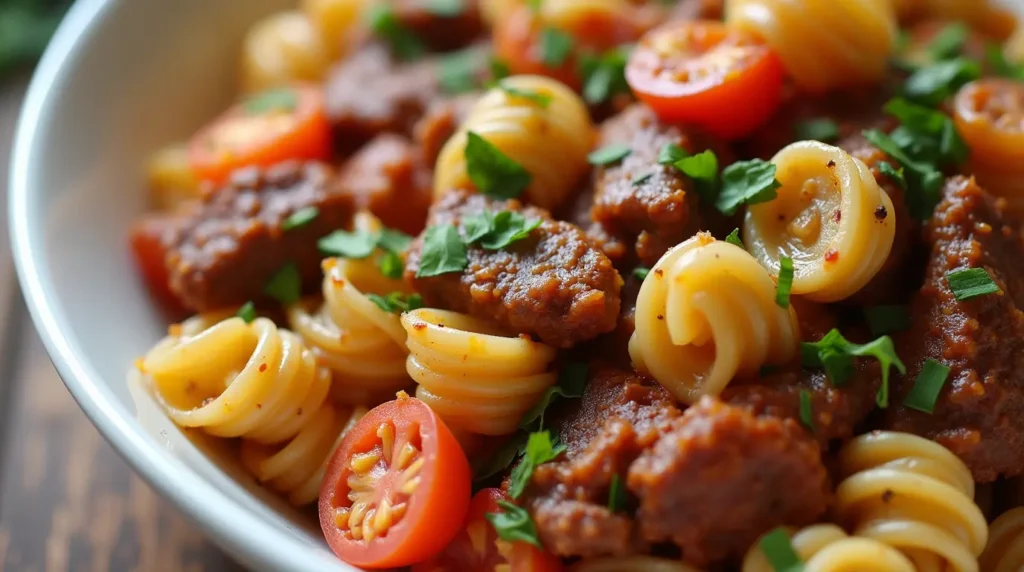Few dishes embody luxury and comfort quite like a lobster pasta recipe. Whether you’re hosting a special dinner or treating yourself to a gourmet meal, mastering the perfect lobster pasta recipe can transform an ordinary evening into an unforgettable culinary experience.
But crafting a lobster pasta that balances the delicate sweetness of lobster with the rich, creamy sauce and perfectly cooked pasta isn’t as simple as it seems. That’s why we’ve compiled 10 foolproof tips to help you elevate your lobster pasta recipe. From choosing the right lobster to perfecting your sauce, this guide will walk you through every step to ensure your lobster pasta recipe is nothing short of spectacular.
Table of Contents
1. Choosing the Right Lobster for Your Lobster Pasta.
The foundation of any great lobster pasta recipe starts with high-quality lobster. Here’s what you need to know:
- Fresh vs. Frozen Lobster: Fresh lobster is ideal for its superior flavor and texture, but frozen lobster tails are a convenient and equally delicious alternative when fresh isn’t available for your lobster pasta recipe.
- Whole Lobster vs. Lobster Tails: Whole lobster offers the advantage of claw meat, which is tender and flavorful. However, lobster tails are easier to work with and still provide a rich, meaty texture for your lobster pasta recipe.
- Sourcing Tips: Visit a trusted seafood market or look for sustainably sourced lobster. Websites like Seafood Watch can help you choose eco-friendly options.
2. Preparing Lobster Like a Pro for Your Lobster Pasta.
Proper preparation is crucial to getting the most out of your lobster in the lobster pasta recipe.
- Cooking Methods: Boiling and steaming are the most common methods for lobster pasta recipes. Boiling is faster, while steaming retains more of the lobster’s natural flavor.
- Extracting the Meat: After cooking, use kitchen shears to cut through the shell and remove the meat without damaging its delicate texture for your lobster pasta recipe.
- Avoiding Overcooking: Lobster meat turns rubbery if overcooked. Aim for an internal temperature of 140°F for perfectly cooked lobster in your lobster pasta recipe.
3. Perfecting the Pasta for Lobster Pasta
Your choice of pasta can make or break your lobster pasta.
- Best Pasta Types: Linguine and fettuccine are popular choices for lobster pasta recipes because they hold the sauce well, ensuring each bite is flavorful.
- Cooking to Al Dente: Follow the package instructions, but aim for al dente to provide a satisfying bite and prevent the pasta from becoming mushy in your lobster pasta recipe.
- Pasta Water Magic: Reserve a cup of pasta water before draining. Its starchy content helps thicken the sauce and bind it to the pasta in your lobster pasta.
4. Crafting a Flavorful Sauce for Your Lobster Pasta
The sauce is the heart of your lobster pasta. Here’s how to make it unforgettable:
- Key Ingredients: Garlic, butter, heavy cream, and white wine are essentials. They create a rich, velvety base that complements the sweetness of lobster in your lobster pasta recipe.
- Balancing Flavors: Add a splash of lemon juice for acidity and freshly cracked black pepper for a subtle kick in your lobster pasta recipe.
- Fresh Herbs: Incorporate thyme, parsley, or chives to enhance the sauce’s complexity in your lobster pasta recipe.
5. Building Layers of Flavor in Your Lobster Pasta
Small steps can elevate your lobster pasta recipe from good to extraordinary.
- Toasting Garlic: This enhances its natural sweetness and adds depth to your lobster pasta recipe’s sauce.
- Wine Reduction: Cooking with wine not only deglazes the pan but also infuses the lobster pasta recipe’s sauce with a rich, tangy undertone.
- Seasoning Stages: Salt your sauce in layers as it cooks to develop a well-rounded flavor profile for your lobster pasta.
6. Incorporating Lobster into the Sauce for Your Lobster Pasta
Timing is everything when it comes to combining lobster with your sauce in a lobster pasta recipe.
- When to Add Lobster: Stir the lobster meat into the sauce during the final few minutes of cooking to warm it through without overcooking in your lobster pasta recipe.
- Coating the Lobster: Ensure each piece of lobster is fully coated in the sauce for maximum flavor in your lobster pasta recipe.
- Final Adjustments: Taste and adjust seasoning before serving to ensure every element of your lobster pasta recipe is perfectly balanced.
7. Presentation Matters for Your Lobster Pasta Recipe
Visual appeal plays a significant role in elevating your lobster pasta.
- Garnish: Use fresh herbs, lemon wedges, or a sprinkle of Parmesan cheese to add color and texture to your lobster pasta.
- Plating Tips: Twirl the pasta into nests and top with lobster pieces for a professional touch in your lobster pasta recipe.
- Drizzle Extra Sauce: Finish with a light drizzle of sauce to enhance the visual appeal and flavor of your lobster pasta.
8. Pairing Your Lobster Pasta Recipe with Wine
A well-paired wine can elevate your lobster pasta to new heights.
- Best Pairings: Chardonnay and Sauvignon Blanc are excellent choices. They complement the creamy sauce without overpowering the delicate lobster in your lobster pasta recipe.
- Non-Alcoholic Options: Try sparkling water with a twist of lemon for a refreshing contrast to your lobster pasta recipe.
9. Storing and Reheating Your Lobster Pasta
Leftovers from your lobster pasta can be just as delicious when handled correctly.
- Refrigeration: Store leftover lobster pasta in an airtight container in the fridge for up to three days.
- Reheating: Warm leftovers gently on the stovetop, adding a splash of milk or cream to restore the sauce’s creaminess in your lobster pasta.
- Freezing: While not ideal, you can freeze lobster pasta. Thaw overnight in the fridge and reheat as described.
10. Common Mistakes to Avoid in Your Lobster Pasta Recipe
Steer clear of these pitfalls to ensure a flawless lobster pasta:
- Overcooking Lobster or Pasta: Leads to a rubbery texture and soggy pasta in your lobster pasta.
- Overpowering the Sauce: Avoid overwhelming the lobster’s natural sweetness with heavy spices or too much salt in your lobster pasta.
- Skipping Key Steps: Don’t rush through preparation; every step contributes to the final flavor of your lobster pasta.

Ingredient Table for Lobster Pasta
| Ingredient | Quantity | Notes |
|---|---|---|
| Lobster tails | 2 large | Fresh or frozen, thawed |
| Pasta | 300g | Linguine or fettuccine |
| Garlic | 4 cloves | Minced |
| Butter | 4 tbsp | Unsalted |
| Heavy cream | 1 cup | Full-fat for creaminess |
| White wine | 1/2 cup | Dry |
| Fresh herbs | To taste | Thyme, parsley, chives |
Conclusion: Master Your Lobster Pasta Tonight
Now that you’re armed with these 10 foolproof tips, it’s time to roll up your sleeves and create a lobster pasta that rivals your favorite restaurant. Whether it’s for a romantic dinner or a special occasion, your lobster pasta will impress every time.
Ready to take your lobster pasta recipe to the next level? Try these tips tonight and transform your dinner into a culinary masterpiece!

FAQs about Lobster Pasta
Q1: Can I use frozen lobster for lobster pasta?
Absolutely! Frozen lobster tails are a convenient alternative. Just ensure they’re properly thawed for the best texture and flavor in your lobster pasta.
Q2: What type of pasta works best with lobster?
Linguine and fettuccine are top choices for your lobster pasta as they hold the sauce well, making each bite flavorful.
Q3: How do I avoid overcooking lobster?
Cook lobster until just opaque. Overcooking can lead to a rubbery texture, so monitor closely while preparing your lobster pasta.
Q4: Can I add other seafood to my lobster pasta ?
Yes! Feel free to add shrimp, scallops, or crab to enhance your lobster pasta further.

